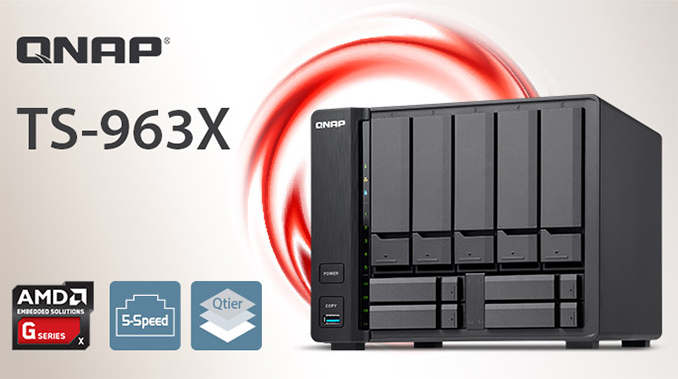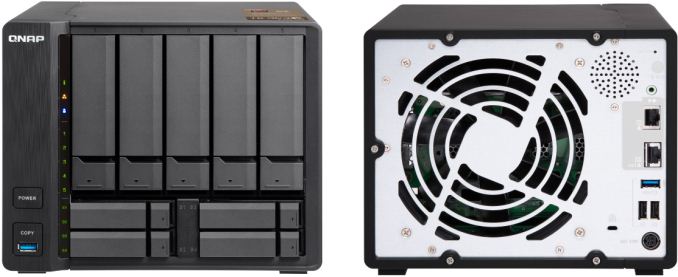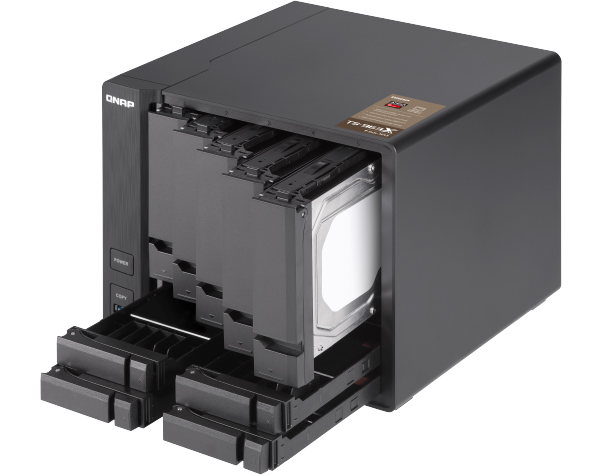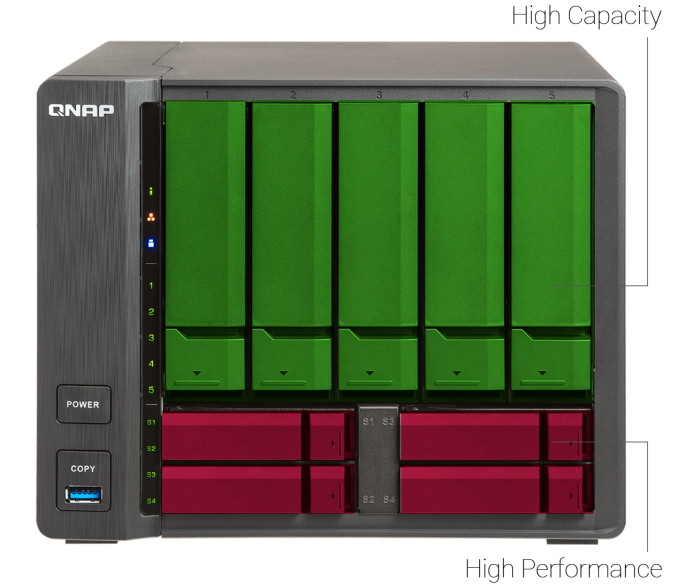QNAP Launches TS-963X NAS: x86 NAS With 9 Bays & 10 GbE/Multi-Gig Ethernet
by Anton Shilov on May 10, 2018 4:00 PM EST
QNAP this week has taken the wraps off of their new 9-bay NAS family, the TS-963X series. The new storage devices sports a mix of 3.5-inch and 2.5-inch drive bays with support for the company’s Qtier file/data tiering technology, and also features integrated 10GBASE-T connectivity. Being the first 10GbE-enabled NAS in its class, the QNAP TS-963X products are primarily aimed at small businesses that need high capacity and fast access time.
The QNAP TS-963X NAS features five hot-swappable 3.5-inch bays for high-capacity SATA HDDs as well as four hot-swappable 2.5-inch bays for high-performance SATA SSDs or HDDs (keep in mind that the latter may be hard to find). The NAS is based on AMD’s GX-420MC SoC (two Excavator modules, 2 GHz, 2 MB L2 cache, Radeon iGPU with 128 stream processors, a 256-bit AES encryption engine, 17.5 W TDP) and run QNAP’s QTS 4.3 operating system. The latter supports various features, including snapshots, virtual JBOD, Qsync cross-platform file sharing (for Apple, Windows, and Linux machines), one touch copy as well as Qtier technology that automatically organizes frequently used file/data into tiers (by moving frequently used data to SSDs).
The QTS 4.3 can also support various first-party and third-party apps that can further enhance functionality of the QNAP TS-963X. For example, the Hybrid Backup Sync can synchronize files with local, remote, and cloud storage; the QVR Pro offers features required by a surveillance solution; whereas Virtualization Station enables users to host virtual Windows/Linux/Unix machines on a NAS (the TS-963X is VMware as well as Citrix ready, and is Windows Server certified).
One of the key features of the QNAP TS-963X NAS is integrated 10GBASE-T network card that supports 10 GbE, 5 GbE, 2.5 GbE, 1 GbE, and 100 MbE speeds. The TS-963X is one of the first NAS for small businesses to feature 10 GbE and multi-gig connectivity over an RJ45 connector using Cat5e/Cat6 cabling. As 10GBase-T and NBase-T networks become more widespread, 10 GbE NICs inside SMB-oriented NASes will become more widespread, but for now the TS-963X will offer this feature exclusively. QNAP’s NAS uses Aquantia’s relatively affordable AQtion AQC107 network chip, so the capability does not necessarily increase its pricing significantly.
QNAP says that the TS-963X will be available shortly in two versions: the TS-963X-2G with 2 GB DDR3L memory as well as the TS-963X-8G with 8 GB of DDR3L memory. The manufacturer yet has to disclose pricing of its new NAS, but it says that the TS-963X will carry a “budget-friendly” MSRP.
| QNAP TS-963X NAS | |||
| TS-963X-2G | TS-963X-8G | ||
| CPU | Model | AMD GX-420MC | |
| Cores/ Threads |
2M/4T | ||
| Freq. | 2 GHz | ||
| L2 Cache | 2 MB | ||
| TDP | 17.5 W | ||
| Encryption Acceleration | 256-bit AES | ||
| Memory | Speed | DDR3L, two DIMM slots | |
| Capacity | 2 GB, single-channel | 8 GB, single channel | |
| Bays | 5 × 3.5" 4 × 2.5" |
||
| Storage interface | SATA 6 Gbps | ||
| Ethernet | 1 × GbE 1 × 10 GbE |
||
| PCIe Slots | 1 × PCIe 3.0 x8 2 × PCIe 3.0 x4 |
||
| Audio | 1 speaker 1 × audio out |
||
| USB | 2 × USB 3.0 Type-A 2 × USB 2.0 Type-A |
||
| Other I/O | Copy button, buzzer, LED notifications, etc. | ||
| Dimensions | Height | 182 mm | 7.17" | |
| Width | 225 mm | 8.86" | ||
| Depth | 224 mm | 8.82" | ||
| Power Consumption | Standby | 35.64 W | |
| Operating | 53.06 W | ||
| OS | QNAP QTS 4.3 | ||
| MSRP | ? | ? | |
Related Reading:
- QNAP Begins to Ship AMD Ryzen-Based TS-x77 Series NAS: 6, 8, 12 Bays
- QNAP Launches TS-1277 NAS Powered by AMD's Ryzen CPUs: 12 Bays, 64 GB DDR4, Starts at $2,299
- QNAP at CES 2017 - Thunderbolt 3 and Xeon D NAS Units, Residential Gateways, and More
- Synology at CES 2017 - RT2600ac Wi-Fi Router, DSM Value Additions, and New Business NAS Units
- Netgear Expands ReadyNAS Lineup with Intel Denverton Atom Platform
Source: QNAP













17 Comments
View All Comments
stuffwhy - Thursday, May 10, 2018 - link
Why do you say high performance 2.5 inch SATA SSDs may be hard to find? Is this a reference to a type of drive other than ones such as the Samsung Evo 860?Kjella - Thursday, May 10, 2018 - link
The "latter" would be referring to high performance HDDs, which has pretty much died as a category after SSDs arrived.plopke - Thursday, May 10, 2018 - link
I have no clue about embedded cpu market but can anyone give some possible explanations about why they ended up with a AMD Excavator cpu. What does make these so appealing.Ian Cutress - Thursday, May 10, 2018 - link
99.99% of the time is just managing data, which is not a CPU intensive task. Embedded CPUs have long life cycles, 7-10 years or more, with guaranteed hardware stability and specific features. For non-personal NAS deployments that have a cycle of this level, having that stability is a must for QNAP's customers. The embedded market has long cycles and focuses on stability once a minimum performance level has been reached.novastar78 - Thursday, May 10, 2018 - link
Seems quite simple why if you think about it, AMD probably has a boatload of these chips around and a need to get rid of them. Heat and power is not much a problem because there aren't many very CPU intensive tasks to do her.They probably gave them to QNAP for almost nothing...
duploxxx - Friday, May 11, 2018 - link
lol base garbage reply and commented by another garbage reply.why AMD soc? oh dear really you think it all needs to be intel to be good? Actually the socs from AMD do pretty well in these markets due to there much better graphical performance while single thread CPU power is not the focus of these markets.
gave them for free, boat load of chips. its a specific chip design :) just like Xbox and PS. Those are also garbage right because they are not intel based
https://www.amd.com/Documents/AMDGSeriesSOCProduct...
BurntMyBacon - Friday, May 11, 2018 - link
While I don't disagree that this chip should be perfectly capable of doing its intended job, I have to wonder how AMD's superior graphical performance is supposed to help with a product that doesn't even have video outputs. I'm pretty sure that neither the file system tasks, nor the TCP/IP stack are being offloaded to the GPU.jospoortvliet - Saturday, May 12, 2018 - link
Maybe transcode video? I must say it is a stretch...praeses - Thursday, May 10, 2018 - link
Also many of the low power (Atom/Puma/etc) DDR4 variants do not support ECC. For low power the previous generation seems to be a better match. I don't know whether this unit supports ECC or not though. In this segment AMD typically uses a little more juice but the chipsets (or SoC) usually offer more PCIe lanes or integrated SATA ports which can make for cheaper solutions.BurntMyBacon - Friday, May 11, 2018 - link
The memory modules listed on QNAP's website are not ECC modules, so I'd guess the platform does not support ECC modules.